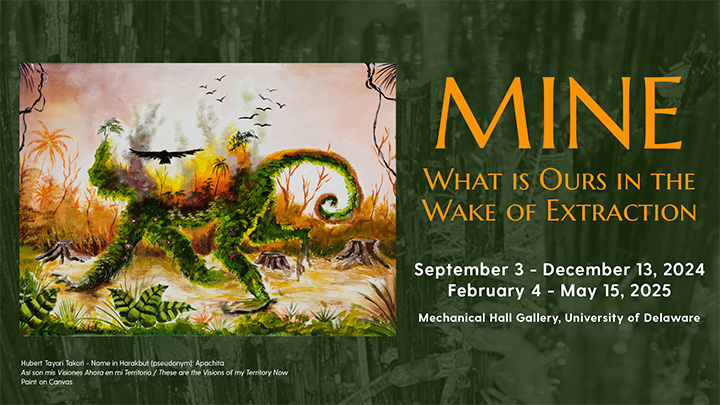About This Exhibition:
The Amazon is on the brink of collapsing, and with it, Indigenous cultures and lands are at risk of disappearing. Over the past 20 years, the Harakbut Indigenous community from the Madre de Dios region in the Peruvian Amazon has been devastated by an illegal gold mining boom. This boom is a result of the egregious demand for gold used in phones, electronics and jewelry, which is largely driven by Western consumer habits. The illegal mining has led to immense pollution of the air, land and water; deforestation; disease; human trafficking; drug smuggling; disparate economies; and an all-too-real danger of losing the culture and traditional ecological knowledge of the Harakbut and other tribes.
In MINE: What is Ours in the Wake of Extraction, visitors can become part of the solution by learning about the Harakbut culture through the works of the Etochime Artist Collective. The collective’s artworks speak to Indigenous worldviews and the disastrous impact the extractive industries have had on their land and people. The exhibition will also feature specimens from the Mineralogical Museum known as conflict minerals – mined resources that contribute to environmental harm and are frequently used to finance armed conflict and human rights abuses – as well as a juried selection of 10 artworks from around the globe, emphasizing that these issues aren’t only happening in and affecting the Amazon.
The exhibition is presented in collaboration with The ACEER Foundation, Amazon Aid, AWA and Studio Verde. It is on view September 3 - December 13, 2024, and February 4 - May 15, 2025, in Mechanical Hall Gallery on the University of Delaware’s Newark campus. Mechanical Hall Gallery is open to the public Tuesday through Friday from 10 a.m. to 4 p.m. Admission is free.
La selva Amazónica está al borde del colapso y sus culturas y territorios indígenas corren el riesgo de desaparecer. Durante los últimos 20 años, la comunidad indígena Harakbut de la región de Madre de Dios en la Amazonía peruana ha sido devastada por un auge de la minería ilegal de oro. Este auge es el resultado de la enorme demanda de oro utilizado en teléfonos, productos electrónicos y joyería, impulsada en gran medida por los hábitos de consumo occidentales. La minería ilegal ha provocado una inmensa contaminación del aire, la tierra y el agua; deforestación; enfermedad; trata de personas; tráfico de drogas; economías dispares; esto hace que la cultura y el conocimiento ecológico tradicional de los Harakbut y otras comunidades originarias están en peligro de perderse.
En MINE: What is Ours in the Wake of Extraction, los visitantes pueden convertirse en parte de la solución aprendiendo sobre la cultura Harakbut a través de las obras del colectivo de arte Etochime. Estas obras representan sus cosmovisiones y el impacto desastroso que las industrias extractivas han tenido en sus tierras y su gente. La exposición también incluirá especímenes del Museo Mineralógico conocidos como minerales de conflicto (recursos minados que contribuyen al daño ambiental utilizados con frecuencia para financiar conflictos armados generando abusos contra los derechos humanos), así como una selección por jurado de 10 obras de arte internacional, enfatizando que estos problemas no sólo ocurren y afectan al Amazonia.
La exposición se presenta en colaboración con la Fundación ACEER, Amazon Aid, AWA y Studio Verde. Estará presentada del 3 de septiembre al 13 de diciembre de 2024 y del 4 de febrero al 15 de mayo de 2025 en Mechanical Hall Gallery del campus de Newark de University of Delaware. Mechanical Hall Gallery está abierta al público de martes a viernes de 10 a.m. a 4 p.m. La admisión es gratis.
Credits:
Exhibition curated by Jon Cox, associate professor of art, University of Delaware; Patsy Craig, founder/director of AWA Galleria in Cusco, Peru; Sharon Fitzgerald, curator of the Mineralogical Museum, University of Delaware; Maisie McNeice, founder of Studio Verde, Italy; Amanda Zehnder, chief curator and head of Museums, University of Delaware


